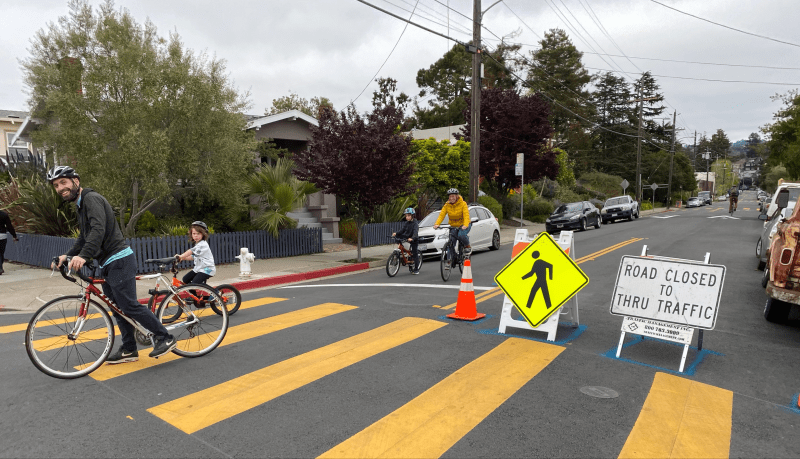The City Council bill that could force the de Blasio administration to open 75 miles of streets to pedestrians and cyclists doesn't say much, but still packs a punch, according to legislators and observers.
The bill, which will be debated at a virtual Transportation Committee hearing on Friday morning, comprises less than a single page and just four sections. Legislators don't lay out how the open streets plan would be put together. Instead, the bill offers a couple of definitions of the type of open streets the Council wants, taking into account such issues as keeping every road user safe, instituting the open streets in areas that don't have tons of open space and making sure that deliveries and emergency vehicles can move around.
But the specifics of the program's location and design are left with the Department of Transportation. Asking the administrators to administer is the bill's goal, by design.
"There is some City Council legislation meant to become law and some that is more in the area of political communication," said Jon Orcutt, the communications director at Bike New York and the former director of policy at the DOT.
But even though this bill is political nature, it shouldn't be mistaken for pure grandstanding, he added. The Council is just moving ahead in the same way that it had to when it dragged the mayor by the nose to Fair Fares or the streets master plan.
"The Council has figured out you have to pressure the mayor here, compared to the way that other world cities are getting ready for social distancing," said Orcutt.
A bill that tells the DOT to do something could theoretically still result in no action, but Orcutt said that a rapid introduction and hearing on the bill will keep the pressure on the de Blasio administration to negotiate with the Council by keeping public attention focused on the issue of open streets — and how they should be created. The NYPD's original open streets pilot lasted just 11 days, with the mayor ultimately concluding that it required too many police resources, though other cities are doing it without any cops at all.
Council Speaker Corey Johnson favors the light- or no-enforcement model created by the DOT, not the NYPD.
"If you work with the DOT, with communities, you will be able to put together a safe streets program that will work and will not need a massive amount of enforcement," Johnson told reporters on Wednesday.
The bill's sponsor Carlina Rivera of Manhattan said she hoped DOT would work with existing organizations so that the streets can be opened quickly.
"Some of the streets we're looking at have been recommended by block associations, by businesses improvement districts and civic associations," Rivera told Streetsblog. "We already have a long list of allies on this, and more people will want to be included I'm sure."
As for the DOT itself, a spokesperson for the agency declined to say whether anyone from the agency will testify, though Commissioner Polly Trottenberg does typically present the administration's position on pending legislation.
Rivera stressed that she sees the Council effort as a pilot for a larger open streets plan that does not need to be an overpoliced mess (video here). The bill also requires the DOT to report on the pilot's successes and failures so the city can determine which aspects of the plan can be expanded or made permanent — another stark difference from the mayor's metrics of success which seemed to boil down to "the police didn't like it."
"The other pilot was too narrow in scope," said Rivera. "Six blocks in a dense area of Manhattan wasn't the innovative solution we needed for people. And that's what the reporting structure is for, to create a working partnership with DOT in order to make this the type of pilot that we can measure its success."
Rivera said she didn't buy the mayor's comments about how California drivers are more courteous as a reason why our city can't open streets as Oakland did. But she also said that the open streets movement's biggest and tallest opponent can be convinced of the importance of providing extra space for New Yorkers — hopefully before the warm weather returns, said Orcutt.
"You need to uncork this whole topic at the top," he said. "If there's 20 percent more car traffic when things start to reopen [because of subway and bus fears], it will be hard to do this. So we need to mark the space out now so that drivers know it when they come back."
How things get uncorked is yet to be seen, but Rivera is playing the role of carrot in reaching out to DOT, while Johnson is comfortable being the stick.
"[The mayor] could veto the bill and we could over-ride the veto," he said, making it clear that the mayor's view is a minority one.
Rivera said she didn't think it would come to that though because too many New Yorkers are interested in taking back their streets.
"There's a collective investment from communities to keep everyone safe, and safety starts with social distancing" Rivera said. "We should allow New Yorkers to have space available to them, but we're using so much of our space the wrong way."
Opposition within the Council seems muted. Queens Council Member Eric Ulrich called the plan "asinine" this week, but it appears he was merely speaking in the context of his outrage over subway homelessness, a crucial issue, though one not related to the open streets plan (especially if the NYPD is not involved).






